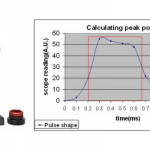Quite often we receive questions about the minimum power parameter provided in our power sensor data sheets. For example, customers ask what would happen if they used a sensor with a minimum power rating of 20 mW to measure a 15 mW beam. Or how much above the minimum power should you be to get a reasonably accurate reading?
There are two main sources of interference with the correct reading at low powers:
- Noise, i.e. random fluctuations in reading due to electrical or thermal interference
- Offset, i.e. a constant or changing erroneous reading giving a nonzero reading with no optical input. This is due to an extraneous source of light or heat that you are not trying to measure that gets into the sensor or an extraneous source of heat from the sensor itself (such as a hot sensor head).
The first item above, noise, is usually what is given in specifications of this type. There is no agreed upon standard for “minimum measurable power”. The least stringent interpretation, taken by some manufacturers is that the minimum measurable power is that where the signal equals the standard deviation noise or RMS noise. By this definition, at this level, you can see that there is a signal but certainly cannot get a numerical value out of it since your signal equals the noise. Another definition sometimes given is where the signal is 10 times the RMS noise. In this case, with careful measurement, you should be able to determine the value of the signal within ±10%. Ophir takes the most stringent interpretation of minimum measurable power: where the signal is 20 times the 3 sigma noise (60 times the RMS noise). This is 6 times as stringent as the previous definition and with this definition you should easily be able to get ±5% accuracy or better.
The second source of interference, offset, given above does not always needs to be taken into account. With careful setup, the user can usually eliminate stray sources of input light or subtract them using the offset function. Furthermore, the effect of heating of the sensor head is usually taken into account in the calibration and specification of the sensor so it is not a factor either. However, when the second source of incorrect reading is important and cannot easily be eliminated by the user, then it is explicitly taken into account. For instance, for the Ophir sensitive thermal sensor 3A, a specification is given for reading drift as well as noise, where the drift comes from small changes in background room temperature. In this case, the expected drift is defined to be under normal room conditions including air conditioning switching on and off.
As an illustration of the above, if a sensor has a noise level of 0.3mW RMS it is not meaningful to try to measure less than 0.3mW. For such a sensor Ophir will specify that the minimum power is 20mW. At such a power level, you should be able to measure easily to ±5% accuracy and with some effort to ±2% accuracy. So in answer to the questions that were asked above, it is not a problem to measure 15mW with such a sensor only the accuracy of your measurement will be somewhat less. Likewise, it is up to the user to decide what accuracy he wants and what minimum powers to measure. Ophir has merely given guidelines for minimum power that assure you of a really usable measurement at that value.
Thus, when comparing the stated minimum measurable power of Ophir sensors and of competing sensors, customers may be misled to think the competitor’s sensors can measure lower powers. But usually, the competitor simply has a lower standard of acceptable error. In order to truly compare between sensors, find out the standard acceptable error rating of the competitor.
You might also like to read:
Easy solutions for measuring low power beams
Share this:












Leave a Reply
Your email address will not be published. Required fields are marked *